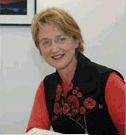|
|
|
|
|
|
|
News & Views item - August 2009 |
![]() Chief Executive of New Zealand's Ministry of Research, Science and Technology
Speaks at AAAS. (August 19, 2009)
Chief Executive of New Zealand's Ministry of Research, Science and Technology
Speaks at AAAS. (August 19, 2009)
 Last
month Helen Anderson, the chief executive of New Zealand's Ministry of Research,
Science and Technology gave a lecture at the Washington DC Science Policy
Alliance, sponsored by the American Association for the Advancement of Science and the New
Zealand Embassy.
Last
month Helen Anderson, the chief executive of New Zealand's Ministry of Research,
Science and Technology gave a lecture at the Washington DC Science Policy
Alliance, sponsored by the American Association for the Advancement of Science and the New
Zealand Embassy.
Dr. Anderson, a seismologist, is a specialist in the mechanics of large earthquakes and before becoming CE of MoRST she worked at New Zealandís Department of Scientific and Industrial Research and one of its successors, Geological and Nuclear Sciences (GNS), a Crown Research Institute.
She told her Washington DC audience: "We have a unique perspective that we can and, indeed, must offer in finding solutions to global environmental challenges," and went on to say that it "is a great natural laboratory for unravelling the mysteries of our environment."
With regard to practical matters she said her country has been actively pursuing wind energy and noted the strong winds that sweep across both islands. Currently there are 400 megawatts of installed wind energy capacity, 100 megawatts under construction, and another gigawatt of capacity is under discussion.
On the geothermal front Dr Anderson said: "Harnessing that resource is a very science-intensive activity," and noted that New Zealand was a pioneer in developing geothermal plants in the 1950s which at present account for about 10 to 12% of the nation's electricity production. In addition a facility under development is expected to have double the efficiency in utilising underground steam compared with existing plants.
According to the AAAS write-up: "The geothermal work has been feeding into an Energy Development in Island Nations (EDIN) initiative by New Zealand, Iceland, and the U.S. Department of Energy. One aim of the year-old initiative is to exploit geothermal energy sources to help promote energy self-sufficiency in some Pacific islands. The joint initiative is meant to enhance global energy security and address global climate change through the promotion of clean, renewable, sustainable energy technologies."
One of New Zealand concerns is that about 52% of its greenhouse emissions come from agricultural, methane emission from the 38 million sheep and 10 million head of cattle. As a greenhouse gas, methane is 20 - 25 times as efficient as C02, and Dr Anderson said: "Our scientists are working to better understand and control what happens in the stomachs of sheep and cows."
The challenge is not just significant for New Zealand. The United Nations Food and Agriculture Organization has calculated that, when added to emissions from manure, the methane from the guts of ruminant animals accounts for about 80% of the world's agricultural methane emissions, Dr Anderson said, and accounts for 35 to 40% of all humanity's methane emissions.
"This is one area where New Zealand science, through technology transfer, can
not only address our own challenges, but can help reduce emissions well beyond
our own shore," Dr Anderson said and added: "Science is an international
activity, and often the boundaries of science have little to do with
international boundaries. Science often occurs in spite of international
boundaries not because of them. But the challenges we face are international and
require the best in thinking that we can come up with globally."
Finally, Earl Lane in his report writes: "Asked about attitudes toward science in her nation, Anderson said that New Zealanders hold science in high regard but do not think it is relevant to their lives. 'Now that's amazing,' she said.
"Her agency is working with teachers to help develop resources to tell youngsters the relevance of New Zealand science through the eyes of young researchers in Antarctica and in fields such as sports science. 'But look, no one has a silver bullet on this one,' Anderson said. She mentioned President Barack Obama's renewed emphasis on science as part of policy-making, and said it 'is an extremely important signal to scientists worldwide and I hope that it will also be seen as relevant to young people who want to take up science.'"